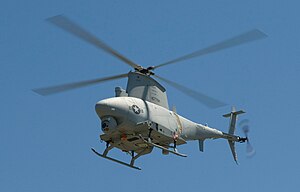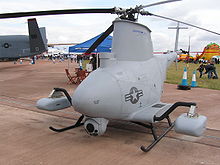Northrop Grumman MQ-8 Fire Scout: Difference between revisions
m + {{commonscat}} |
→Operational history: add reference for LRIP |
||
| Line 59: | Line 59: | ||
Production of the flight test airframes was initiated in April 2006 at the Northrop Grumman Unmanned Systems production plant in [[Moss Point, Mississippi]]. First flight of the MQ-8B took place on [[December 18]], [[2006]] at [[Naval Air Station Patuxent River|NAS Patuxent River]]. |
Production of the flight test airframes was initiated in April 2006 at the Northrop Grumman Unmanned Systems production plant in [[Moss Point, Mississippi]]. First flight of the MQ-8B took place on [[December 18]], [[2006]] at [[Naval Air Station Patuxent River|NAS Patuxent River]]. |
||
The flight test program is underway and the Navy approved low-rate initial production. |
The flight test program is underway and the Navy approved low-rate initial production.<ref>http://www.irconnect.com/noc/press/pages/news_releases.html?d=160037 Navy awards 3rd LRIP contract</ref> Production aircraft will eventually be deployed on the Navy's [[Littoral Combat Ship]]s. |
||
In February 2008, the U.S. Navy announced that they would integrate the MQ-8B Fire Scout VTUAV onto another air-capable ship before it reaches the Littoral Combat Ship (LCS).{{Fact|date=February 2009}} The Fire Scout is still slated to go aboard the LCS, and the Navy remains committed to transitioning the Fire Scout in that direction. |
In February 2008, the U.S. Navy announced that they would integrate the MQ-8B Fire Scout VTUAV onto another air-capable ship before it reaches the Littoral Combat Ship (LCS).{{Fact|date=February 2009}} The Fire Scout is still slated to go aboard the LCS, and the Navy remains committed to transitioning the Fire Scout in that direction. |
||
Revision as of 00:45, 25 February 2009
This article includes a list of general references, but it lacks sufficient corresponding inline citations. |
| MQ-8 Fire Scout | |
|---|---|

| |
| A USN MQ-8B with the BRITE Star II electro-optical/infrared payload at Webster Field, NAS Patuxent River, Maryland | |
| Role | UAV helicopter |
| Manufacturer | Northrop Grumman |
| First flight | 2002 |
| Introduction | 2003 |
| Primary users | United States Navy United States Army |
| Developed from | Schweizer 330 and 333 |
| Variants | Schweizer S-434 |
The Northrop Grumman MQ-8 Fire Scout is an unmanned autonomuous helicopter developed for use by the United States armed forces.[1] Northrop Grumman is developing the Fire Scout to provide reconnaissance, situational awareness, and precision targeting support. The initial RQ-8A version was based on the Schweizer 330, while the enhanced MQ-8B is derived from the Schweizer 333.
Design and development
RQ-8A
As the US Navy was withdrawing its RQ-2 Pioneers from service, it began to seek a second generation UAV. The Navy requirement specified a vertical takeoff & landing (VTOL) aircraft, with a payload capacity of 90 kilograms (200 pounds), a range of 200 kilometers (125 miles), an endurance on station of three hours at an altitude of 6 kilometers (20,000 ft), and the ability land on a ship in a 46 km/h (29 mph) breeze. The UAV was to fly 190 hours between maintenance.
There were three finalists in the competition, which was designated "VTOL-UAV" or "VTUAV". Bell, Sikorsky, and a collaboration of Teledyne Ryan and Schweizer Aircraft submitted designs. The Ryan-Schweizer UAV was selected as the winner in the spring of 2000. The RQ-8A Fire Scout, as it was named, was a derivative of the Schweizer three-passenger, turbine powered 330SP helicopter, with a new fuselage, new fuel system, and UAV electronics and sensors.
The initial prototype of the Fire Scout was piloted in initial tests, flying autonomously for the first time in January 2000. The Rolls-Royce 250-C20 turbine engine ran on JP-5 and JP-8 jet fuel, which is nonvolatile and safe for shipboard storage.
The Fire Scout was to be fitted with a sensor ball turret that carries electro-optic and infrared cameras, and a laser range finder. It was to be controlled over a data link derived from the Northrop Grumman RQ-4 Global Hawk UAV, operating over a line of sight to a distance of 280 kilometers (172 miles). The control system was to be fitted onto a ship, or could be carried on a Hummer light vehicle for U.S. Marine service.

In January 2006, an RQ-8A Fire Scout landed aboard the U.S. Navy warship USS Nashville while it was steaming off the coast of Maryland near the Patuxent River. This marked the first time an unmanned helicopter has landed aboard a moving U.S. Navy ship without a pilot controlling the aircraft. The USS Nashville, which is an amphibious transport ship, was maneuvering as fast as 17 mph (27 km/h) in the tests.
MQ-8B
Although progress on the project had been regarded as satisfactory, the Navy decided the Fire Scout didn't meet their needs after all, and cut funding for production in December 2001. However, the development program continued, and Northrop Grumman pitched a range of improved configurations to anyone who was interested. As it turned out, the U.S. Army was very interested, awarding a contract for seven improved "RQ-8B" evaluation machines in late 2003. In 2006, it was redesignated "MQ-8B".
The MQ-8B features four-blade main rotor, in contrast to the larger-diameter three-blade rotor of the RQ-8A, to reduce noise and improve lift capacity and performance. The four-blade rotor had already been evaluated on Fire Scout prototypes. They boost gross takeoff weight by 500 pounds to 3,150 pounds (by 225 kg to 1,430 kg), with payloads of up to 700 pounds (320 kg) for short-range missions.
The MQ-8B is fitted with stub wings as well. The wings will serve both an aerodynamic purpose as well as an armament carriage location, to include weapons such as Hellfire missiles, Viper Strike laser-guided glide weapons, and in particular pods carrying the "Advanced Precision Kill Weapon System (APKWS)", a laser-guided 70 millimeter (2.75 inch) folding-fin rocket, which the Army sees as ideal for the modern battlefield. The Army is also interested in using the Fire Scout to carry up to 90 kilograms (200 pounds) of emergency supplies to troops in the field.

The MQ-8B is being modified to permit rapid swapout of payload configurations. The current sensor configuration of a day/night turret with a laser target designator will of course remain an option. Alternate sensor payloads in consideration include a TSAR with Moving Target Indicator (MTI) capability, a multispectral sensor, a SIGINT module, the Target Acquisition Minefield Detection System (ASTAMIDS), and the Tactical Command Data Link (TCDL). The Army wants the Fire Scout to operate as an element of an integrated ground sensor network as well.
The Army interest revived Navy interest in the program, with the Navy ordering eight Sea Scout MQ-8B derivatives for evaluation.
Operational history
Production of the flight test airframes was initiated in April 2006 at the Northrop Grumman Unmanned Systems production plant in Moss Point, Mississippi. First flight of the MQ-8B took place on December 18, 2006 at NAS Patuxent River.
The flight test program is underway and the Navy approved low-rate initial production.[2] Production aircraft will eventually be deployed on the Navy's Littoral Combat Ships.
In February 2008, the U.S. Navy announced that they would integrate the MQ-8B Fire Scout VTUAV onto another air-capable ship before it reaches the Littoral Combat Ship (LCS).[citation needed] The Fire Scout is still slated to go aboard the LCS, and the Navy remains committed to transitioning the Fire Scout in that direction.
The Fire Scout is a key enabler for LCS and significantly contributes to its designated warfare mission areas of anti-submarine warfare, surface warfare and mine warfare. The modular nature of the ship to accomplish the designated mission is complemented by the Fire Scout and its modular mission payload capability. However, due to changes in the LCS development schedule, the Navy intends to conduct the Fire Scout Operational Evaluation (OpEval) aboard USS McInerney (FFG-8).[citation needed] This will provide the fleet with unmanned aerial system support as soon as possible.
According to the current schedule, the Navy will conduct Technical Evaluation on the Fire Scout on the FFG-8 in the fall 2008 and OpEval in the summer 2009. The Fire Scout will reach Initial Operating Capability soon after OpEval in 2009. The Navy will continue to support LCS Initial Operational Test and Evaluation (IOT&E) efforts in fiscal year 2011.[3]
Variants
- RQ-8A
- RQ-8B
- MQ-8B
Operators

- USA
Specifications (Q-8?)
General characteristics
- Crew: 0
Performance
See also
Related development
Aircraft of comparable role, configuration, and era
Related lists
References
- ^ "Autonomous Fire Scout UAV Lands on Ship". Department of Defense. January 24 2006. Retrieved 2008-02-01.
{{cite news}}: Check date values in:|date=(help) - ^ http://www.irconnect.com/noc/press/pages/news_releases.html?d=160037 Navy awards 3rd LRIP contract
- ^ "Northrop lifts Navy to new era for unmanned flight", Aerotech News and Review, 2006-12-22
This article contains material that originally came from the web article Unmanned Aerial Vehicles by Greg Goebel, which exists in the Public Domain.
External links
- Unmanned copter looks shipshape San Diego Union Tribune, January 19, 2006
- Northrop's page on Fire Scout (Select "Fire Scout" from the left hand menu.)
